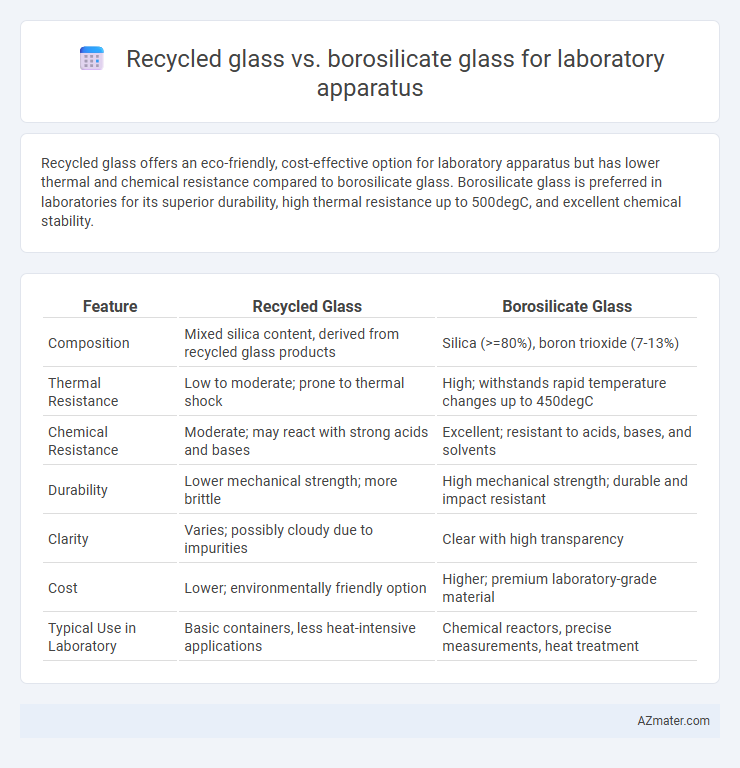Recycled glass offers an eco-friendly, cost-effective option for laboratory apparatus but has lower thermal and chemical resistance compared to borosilicate glass. Borosilicate glass is preferred in laboratories for its superior durability, high thermal resistance up to 500degC, and excellent chemical stability.
Table of Comparison
| Feature | Recycled Glass | Borosilicate Glass |
|---|---|---|
| Composition | Mixed silica content, derived from recycled glass products | Silica (>=80%), boron trioxide (7-13%) |
| Thermal Resistance | Low to moderate; prone to thermal shock | High; withstands rapid temperature changes up to 450degC |
| Chemical Resistance | Moderate; may react with strong acids and bases | Excellent; resistant to acids, bases, and solvents |
| Durability | Lower mechanical strength; more brittle | High mechanical strength; durable and impact resistant |
| Clarity | Varies; possibly cloudy due to impurities | Clear with high transparency |
| Cost | Lower; environmentally friendly option | Higher; premium laboratory-grade material |
| Typical Use in Laboratory | Basic containers, less heat-intensive applications | Chemical reactors, precise measurements, heat treatment |
Introduction to Laboratory Glassware Materials
Recycled glass in laboratory apparatus offers environmental benefits and cost savings but generally lacks the high thermal resistance and chemical durability of borosilicate glass, which remains the preferred material for precise scientific work. Borosilicate glass, composed mainly of silica and boron trioxide, withstands rapid temperature changes up to 450degC and resists chemical corrosion, making it ideal for beakers, flasks, and pipettes. Laboratory glassware made from recycled glass may be suitable for non-critical applications but often cannot meet the stringent standards required for thermal shock resistance and chemical inertness essential in research and industrial laboratories.
Overview of Recycled Glass
Recycled glass in laboratory apparatus offers an eco-friendly alternative by repurposing post-consumer or industrial glass waste, significantly reducing raw material consumption and energy usage during production. While recycled glass often maintains comparable chemical resistance and thermal stability to conventional glass, it may present variability in purity and mechanical strength due to contaminants or mixed compositions. This makes recycled glass more suitable for non-critical lab applications, contrasting with borosilicate glass, which is engineered for superior thermal shock resistance and chemical durability in rigorous experimental environments.
Overview of Borosilicate Glass
Borosilicate glass is a high-quality laboratory material known for its exceptional thermal resistance and chemical durability, making it ideal for precise scientific experiments. It features a low coefficient of thermal expansion, allowing it to withstand rapid temperature changes without cracking, unlike recycled glass which often lacks this thermal stability. The borosilicate composition enhances its resistance to corrosion and chemical reactions, ensuring longevity and reliability in laboratory apparatus.
Chemical Resistance: Recycled vs Borosilicate
Borosilicate glass exhibits superior chemical resistance compared to recycled glass, making it the preferred choice for laboratory apparatus exposed to aggressive chemicals. Its low thermal expansion and high durability prevent corrosion and chemical degradation, ensuring consistent performance in acidic or alkaline environments. Recycled glass, while eco-friendly, often lacks the uniform composition necessary to withstand harsh chemical reactions, limiting its use in precise laboratory applications.
Thermal Properties and Heat Resistance
Recycled glass used in laboratory apparatus typically exhibits lower thermal stability and heat resistance compared to borosilicate glass, which can withstand temperatures up to 500degC without deforming. Borosilicate glass features a low coefficient of thermal expansion (approximately 3.3 x 10^-6 /degC), making it highly resistant to thermal shock and sudden temperature changes, essential for precise laboratory applications. In contrast, recycled glass often has variable composition, resulting in inconsistent thermal properties that limit its use in high-heat laboratory environments.
Durability and Mechanical Strength
Recycled glass generally exhibits lower durability and mechanical strength compared to borosilicate glass, which is engineered to withstand high thermal shock and mechanical stress in laboratory settings. Borosilicate glass contains boron trioxide, enhancing its resistance to thermal expansion and chemical corrosion, making it the preferred choice for lab apparatus requiring longevity and reliability. In contrast, recycled glass may contain impurities and inconsistencies that reduce its structural integrity and suitability for precise scientific applications.
Environmental Impact and Sustainability
Recycled glass significantly reduces raw material extraction, lowers energy consumption, and minimizes landfill waste compared to producing new borosilicate glass, making it a more sustainable choice for laboratory apparatus. Borosilicate glass, while durable and resistant to thermal shock, involves high energy processes and mining of raw materials, contributing to a larger carbon footprint. Incorporating recycled glass into lab equipment manufacturing supports circular economy principles by conserving resources and reducing greenhouse gas emissions.
Cost Considerations for Laboratory Use
Recycled glass for laboratory apparatus offers a cost-effective alternative due to lower raw material expenses and reduced environmental impact, making it ideal for budget-conscious labs. Borosilicate glass, while more expensive initially, provides superior thermal resistance and chemical durability, which can reduce long-term replacement costs and downtime. Evaluating the balance between upfront cost savings and performance longevity is essential for optimizing laboratory budget allocations.
Safety Factors in Laboratory Applications
Recycled glass for laboratory apparatus often contains impurities that can weaken structural integrity and increase the risk of breakage under thermal or mechanical stress compared to borosilicate glass, which offers superior resistance to thermal shock and chemical corrosion. Borosilicate glass is engineered to maintain stability in high-temperature environments and aggressive chemical reactions, making it the preferred choice for safety-critical laboratory applications. Using borosilicate minimizes hazards such as glass shattering or contamination, ensuring reliable performance and protecting laboratory personnel.
Choosing the Right Glass for Your Laboratory Needs
Recycled glass offers environmental benefits and cost savings but may lack the chemical resistance and thermal stability required for precise laboratory applications, making it less ideal for rigorous experiments. Borosilicate glass excels in thermal shock resistance, chemical durability, and clarity, ensuring reliable performance in heating and high-stress conditions typical of lab apparatus. Selecting borosilicate glass is crucial for applications demanding accuracy and safety, while recycled glass can be suited for non-critical or educational lab settings with lower thermal and chemical exposure.

Infographic: Recycled glass vs Borosilicate glass for Laboratory apparatus
 azmater.com
azmater.com